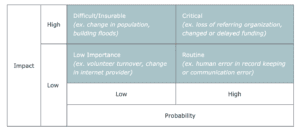Overview
Project Directors/Managers are responsible for planning for and responding to unexpected and unanticipated issues that may impact their Healthy Start (HS) project’s success. Contingency planning, brainstorming, and problem-solving are essential tools for continuously guiding the project toward successful achievement of program goals.
Because HS projects provide critical services to their communities, Project Directors/Managers must identify and control for risk to ensure continuity of those services. Examples of risks that HS projects may experience include:
- Changes to funding: For example, your program has historically received federal HS grant funding as well as state funding, but in the new budget year, state funding is cut entirely.
- Changes to staff: For example, your longtime Consortia Coordinator, who manages your Consortia and has built many important relationships in the community, falls seriously ill.
- Changes to population: For example, the majority of your participants live in a nearby housing development which has been sold, displacing residents from your ZIP code.
- Changes to partners: For example, a partner who is a primary source of referrals goes out of business or changes its processes and can no longer refer to HS.
- Change to location: For example, your physical program space floods or rent doubles and you must move.
Some risks are far less likely, but all organizations should have a plan to mitigate them. These include:
- Legal or ethical misconduct
- Fraud
- Compliance issues
- Damage to reputation
- Reporting of inaccurate or improper information (intentionally or unintentionally)
A risk classification matrix can help you determine the level of threat certain risks pose to the project, and develop an appropriate response. Risks that are Low Impact and Low Probability (e.g., a volunteer that works once a month decides to leave) require minimal planning, while those that are High Impact and High Probability (e.g., a large grant payment to the project is delayed) require thorough consideration and contingency planning. As a rule of thumb, High Probability risks require ongoing monitoring, and High Impact Risks require ongoing management. When considering probabilities, use a long-term timeframe (e.g., 3 to 5 years).

Once you have classified potential risks and developed mitigation strategies, you’re ready to begin implementing those strategies and conducting ongoing monitoring. Be sure to update your matrix when risks change or when lessons learned can be incorporated to improve your mitigation strategies. Remember that risk is a reality and cannot be avoided entirely, so planning for it is your best defense!
Other Resources
- Why All Non-Profits Should Periodically Assess Risk: Provides a framework that all not-for-profit or social service organizations can use as a starting point to implement a periodic risk assessment. Identifies risks facing many organizations, describes the goals of a risk assessment, and suggests steps to mitigate and control risks.
